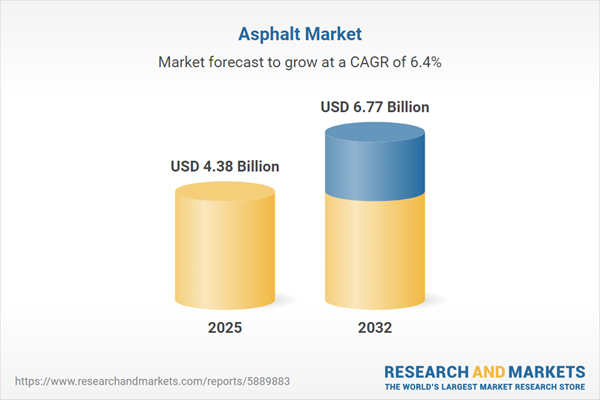Speak directly to the analyst to clarify any post sales queries you may have.
The asphalt market is experiencing notable change as organizations adapt to evolving supply chain requirements, stricter regulations, and procurement complexities. Senior executives now focus on building strategies that sustain competitive advantage while meeting heightened expectations for project delivery and stakeholder satisfaction.
Market Snapshot: Asphalt Market Size and Growth
The global asphalt market continues to grow, underpinned by collaborations between governments and private sector participants who seek to modernize and expand global infrastructure. In 2024, the market is valued at USD 4.12 billion, with anticipated growth to USD 4.38 billion in 2025 and reaching USD 6.77 billion by 2032. This trajectory reflects a projected compound annual growth rate (CAGR) of 6.41%. Increased investments in innovative asphalt materials and a drive for greater supply chain resilience are propelling this upward momentum. Heightened regulatory demands and stricter project standards prompt procurement decision-makers to prioritize agile sourcing strategies and sustainability-focused programs.
Scope & Segmentation of the Asphalt Market
- Product Types: Cold mix asphalt solutions and hot mix variants—such as dense graded, stone mastic, porous, and warm mix—asphalt, designed to address specific project goals and environmental mandates.
- Technologies: Use of conventional asphalts and advanced polymer-modified materials, leveraging additives like crumb rubber, ethylene vinyl acetate, and styrene-butadiene-styrene to boost durability and meet increased sustainability standards.
- Applications: Implementation across road and highway construction, airport runways, commercial parking structures, and pavement management initiatives, requiring effective management of cost, lifecycle, and performance objectives.
- End Users: Governments and private contractors establish procurement benchmarks, influencing purchasing frameworks, supplier engagement, and long-term industry practices.
- Distribution Channels: Direct sales models and distributor networks accommodate diverse project volumes and regions, supporting flexible, responsive sourcing practices and adapting to fluctuations in demand.
- Regions: Coverage extends across the Americas, Europe, Middle East & Africa, and Asia-Pacific, each presenting unique challenges tied to regulatory compliance, supply chain design, and adoption rates for emerging asphalt technologies. Strategic localization helps global participants navigate these factors.
- Key Companies: Leading firms—China Petroleum & Chemical Corporation, PetroChina Company Limited, SK Innovation, Royal Dutch Shell, Exxon Mobil, TotalEnergies, Repsol, Petroliam Nasional Berhad, Indian Oil Corporation, and Nynas AB—demonstrate advanced operational standards and active compliance programs.
Key Takeaways for Senior Decision-Makers
- Adopting advanced asphalt formulations and technologies enhances infrastructure reliability and aligns with evolving sustainability targets.
- Assessing supplier programs for recycling and emissions helps organizations maintain compliance and lower their exposure to shifting regulatory landscapes.
- Customizing procurement processes ensures alignment with both regulatory frameworks and project specifications, enhancing agility and helping manage diverse project risks.
- Establishing partnerships with suppliers recognized for durable materials and innovative additive use strengthens asset longevity and overall project value.
- Collaborating with regional vendors increases supply chain stability and supports mitigation strategies against regulatory or logistics-driven disruptions.
Tariff Impact: Navigating Policy Disruptions
Tariff realignments, especially within the United States, prompt asphalt producers sourcing materials internationally to seek out domestic alternatives and explore new binder compositions. Organizations focused on exports are reassessing market access strategies, and procurement teams are refining sourcing plans to avoid project delays. In this environment, flexibility and solid contingency planning are crucial to successful project continuity and regulatory navigation.
Methodology & Data Sources
This analysis uses both qualitative perspectives and quantitative data, referencing major industry publications and market assessments. Direct input from sector participants ensures that insights reflect current industry dynamics and the priorities of executive decision-makers.
Why This Report Matters to Industry Leaders
- Identifies significant operational benefits derived from the use of modern asphalt methods and advanced material blends for infrastructure projects.
- Offers actionable guidance on optimizing procurement processes and strengthening supply chains in response to heightened compliance demands.
- Provides frameworks and strategies to help executives build strong supplier partnerships and secure reliable material sources at scale.
Conclusion
Resilience in the asphalt market relies on informed procurement strategies and supply chain adaptability. With an emphasis on compliance and flexibility, organizations are prepared to address varying project requirements and evolving industry expectations.
Additional Product Information:
- Purchase of this report includes 1 year online access with quarterly updates.
- This report can be updated on request. Please contact our Customer Experience team using the Ask a Question widget on our website.
Table of Contents
3. Executive Summary
4. Market Overview
7. Cumulative Impact of Artificial Intelligence 2025
Companies Mentioned
The companies profiled in this Asphalt market report include:- China Petroleum & Chemical Corporation
- PetroChina Company Limited
- SK Innovation Co., Ltd.
- Royal Dutch Shell PLC
- Exxon Mobil Corporation
- TotalEnergies SE
- Repsol, S.A.
- Petroliam Nasional Berhad
- Indian Oil Corporation Limited
- Nynas AB
Table Information
| Report Attribute | Details |
|---|---|
| No. of Pages | 180 |
| Published | November 2025 |
| Forecast Period | 2025 - 2032 |
| Estimated Market Value ( USD | $ 4.38 Billion |
| Forecasted Market Value ( USD | $ 6.77 Billion |
| Compound Annual Growth Rate | 6.4% |
| Regions Covered | Global |
| No. of Companies Mentioned | 11 |









